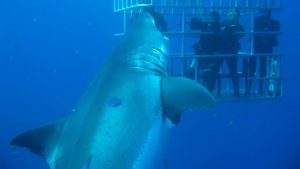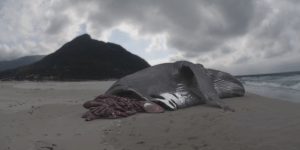The stories of megalodon are generally taken as seriously as those of the Loch Ness Monster and Bigfoot, meaning that most people don’t take them seriously at all. However, there are still several apparent sightings and attacks by these giant oceanic sharks, some with pictures and videos that apparently captured them alive on camera to support the claims.
One thing that differentiates megalodon from other sightings, such as UFOs, Sasquatch, or Nessie, is that there is scientific proof that megalodons really existed. These gigantic sea monsters are estimated to have measured between 50–65 feet (15–20 meters) in length, which is three times the size of the largest great white shark. Such size has inspired Hollywood to consider it as a great topic for a new movie. However, it is believed that the megalodon went extinct around 2 million years ago. The exact timing of their extinction and the reasons behind it remain unclear, though it’s been suggested that declining water temperatures played a significant role.
Over the years, teeth from megalodon have been discovered, but not much else. A picture comparing a megalodon tooth to a tooth from a great white shark helps put things in perspective. Great white sharks are among the largest predators in today’s oceans, able to reach lengths of up to 23 feet (7 meters), which is tiny compared to the megalodon.
There have been several well-known “sightings” throughout the years that apparently show a megalodon shark. Let’s examine some of the more popular ones.
Megalodon during second World War?
One of the earliest sightings with photographic evidence was claimed to have been taken during World War II from a German U-boat off the shores of Cape Town in South Africa in 1942. The photo supposedly depicts a megalodon next to a submarine, with a dorsal fin and tail fin protruding from the water. Based on the submarine’s size, estimates suggest that the span between the tail and dorsal fin is about 65 feet (20 meters) long.
However, this picture appears to be fake for several reasons. The sepia tone used in the photo was not typical for military photos of that era, which were typically black and white. Moreover, the photo went unnoticed for over 70 years before garnering attention, and a subsequent discovery of the same footage in a different format showed no shark. The new footage was taken in the Atlantic, thousands of miles away from Cape Town, and there were no U-boats in that area during the time the photo was supposedly taken. Therefore, this sighting is considered fake.
Megalodon or a Great White Shark?
There is video footage of three divers in a cage, a popular tourist attraction for shark feeding, with a shark and fish swimming around it. The clear footage shows a shark that appears to be almost 25 feet (almost 8 meters) long. Some speculated it might be a young megalodon or a new shark species, but after careful analysis, it was determined to be a great white shark, possibly the largest ever recorded on film.
Megalodon in the Deep Sea?
Following reports of a megalodon living in the Mariana’s Trench, scientists set up cameras, placed bait, and waited. While they did capture footage of several different sharks, one of them appeared gigantic and was initially estimated to be over 40 feet (12 meters) long. Some suggested it might be a sleeper shark, while others argued it was a basking shark. However, the proximity of the shark to the camera made it challenging to gauge its size accurately.
Therefore, while this sighting doesn’t provide proof of megalodon existence, there’s no official evidence of tampering with the footage, and the exact shark species remains inconclusive. More recent size estimations put the shark between 20 and 25 feet (6–7.5 meters) long, considerably smaller than initially thought.
Megalodon during a Rescue Mission?
In a video filmed off the shores of Brazil in 2012, a Coast Guard team rescued someone from the water without noticing anything unusual. It wasn’t until later, upon reviewing the footage, that a large animal swimming just below the surface in the upper portion of the frame was spotted. This video was part of a Discovery ‘Documentary’ series about megalodon that has since been proven to be fake. Therefore, any sightings associated with this series are considered fake as well.
Megalodon bites off Whale?
A photo and video from 2009 purported to show a whale in Hawaii with its tail bitten off, leading to speculation that only a megalodon could inflict such damage. However, both the photo and video are entirely fake, created with CGI for use in the Discovery series on megalodon during Shark Week in 2013 and 2014.
These are just a few of the sightings reported over the years. The term “sightings” is used loosely because there is no definitive proof that any of them are real. Many of these sightings can be traced back to the Discovery Channel and their mockumentary. Discovery has faced criticism for disseminating false information and causing panic and anxiety. Some participants in the shows were actors, while others were real scientists who were misled about what they were documenting, with their responses later edited to appear different. Up until that time, the Discovery Channel was considered an authoritative source for informative programming.
Not all sightings, however, are linked to the Discovery Channel. Are they legitimate sightings? More than likely, no. That’s not to say that all of them are intentionally deceptive, though. Just like the video showing a shark swimming around divers in a cage, the footage is real, but it’s not a megalodon. People also tend to overestimate size, so some who believe they saw a giant shark might have actually just seen a great white shark.
Conclusion
The chances of megalodon still roaming the oceanic waters are nearly nonexistent. During the Pliocene era, many species, including megalodon, went extinct. Scientists believe this was due to the overall drop in ocean temperatures and the changing landscape, which cut off vital nutrients after the Pacific and Atlantic oceans separated.
Moreover, if megalodons were still alive today, there would be a substantial amount of physical evidence, primarily in the form of teeth. Sharks shed teeth regularly, with a single shark losing up to 40,000 teeth in its lifetime. So, even if other physical evidence were scarce, there would be many more teeth washing up on beaches and accumulating on the ocean floor.
If legitimate megalodon sightings existed, we would expect to see teams actively searching for them. Regular shark fins can fetch a high price, so one can only imagine the value of a megalodon fin. Even the commercial recognition of capturing one, without poaching, would be substantial.
The chances of megalodon still existing are exceedingly low, which is somewhat disappointing. It would be fascinating to encounter an animal that people believed went extinct millions of years ago. However, there have been cases where supposedly extinct animals were rediscovered, a phenomenon known as the “Lazarus Effect.” One example is the Coelacanth, which was thought to have gone extinct millions of years ago.




















